
Examples → approfondimenti, e altro
Attenzione: 1/2; 5/4; ... → 0.5; 1.25; ... non 0,5; 1,25; ...
 |  |
| 10 + 5 + 7 | |
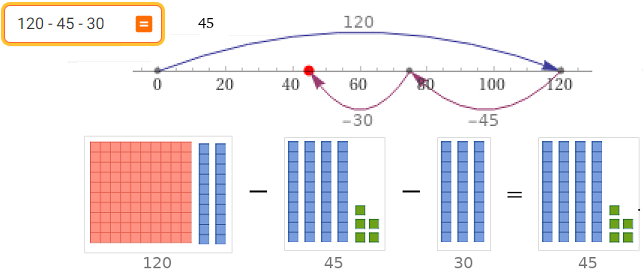
120 - 45 - 30

216-100-20-20-8

7 - 5 + 3 - 5 + 8 -7 + 2 - 8 + 10 5
 |  | 7*5 35/5 |

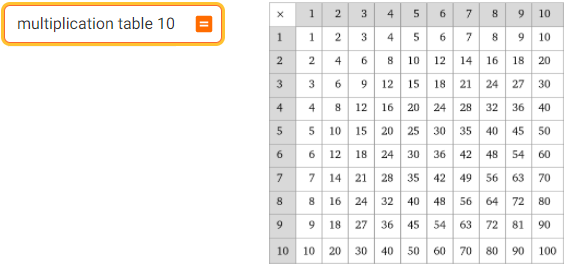
multiplication table 10

7*N for N = 0, 1, 2, 3,..., 11 "for" = "per"

line(-12, -9, -6, -3, 0, 3, 6, 9, 12, 15, 18, 21, 24)

line(7,8,9,10,11,12) line(7,12) line(0, 2.7)
 | place values of 6135 | bar chart 6,1,3,5 |
 |

1563 to roman
 | 912/7 remainder |

from 0 to 90 by 7
 | {7, 9, 15, 16, 17, 21, 23} | sort (7, 23, 15, 21, 17, 16, 9) |

sort("maria","luigi","dario","piera","rosa","alfonso","mario")
 | hand written style ... scrittura "a mano" |

12345 12 mila 345 123456789 123 milioni 456 mila 789

lapis
avvio all'uso delle coordinate
Con WolframAlpha non è possibile tracciare facilmente linee spezzate come quelle fatte con lapis.
With WolframAlpha it is not possible to easily draw chains of segmentes like the ones made with lapis.
plot {(5,5);(10,5);(10,10);(5,10);(5,6);(9,6);(9,9);(6,9);(6,7);(8,7);(8,8);(7,8) }
i punti sono collegati ma passi orizzontali e verticali sono diversi / the points are connected but horizontal and vertical steps are different
plot {(5,5);(10,5);(10,10);(5,10);(5,6);(9,6);(9,9);(6,9);(6,7);(8,7);(8,8);(7,8)} color red
i punti sono colorati / the dots are colored
(5,5);(10,5);(10,10);(5,10);(5,6);(9,6);(9,9);(6,9);(6,7);(8,7);(8,8);(7,8)
passi orizzontali e verticali sono uguali ma i punti non sono collegati / horizontal and vertical steps are the same but the points are not connected

Si può comunque ricorrere a degli script online: vedi "grafici".
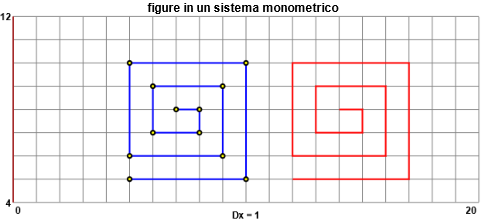
prime equazioni (A) prime equazioni (B)
prime equazioni (C) prime equazioni (D)


percent change variazione percentuale


0.333... 1.333... 2.333... 0.474747... 2.474747...
| 10.1 923076 923076 923076 923076... = ? |  | 10.1923076923076... |

8/(6-2)*(5/3)/2-(3/2/(2*5)+1) | 8/(6-2)*(5/3)/2-(3+2/(2*5)+1)

|
frazioni (+ - * semplifica) |
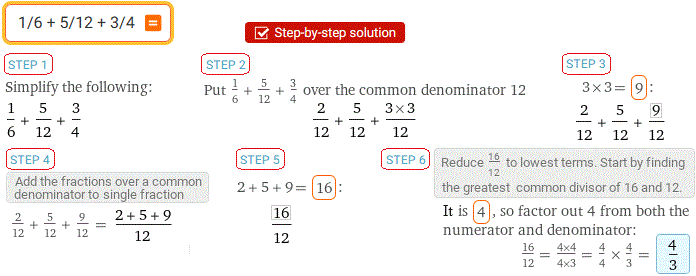
1/6 + 5/12 + 3/4

102/360 123456/123
 | solve ... for x |

Le equazioni dalla forma a/b = c/d (il rapporto tra a e b è uguale a quello tra c e d) sono chiamate anche proporzioni
Equations of the form a/b = c/d (the ratio between a and b is the same as that between c and d) are also called proportions

solve 3x+1 = x-2 for x solve 3x+1 = (2+6x)/2 for x solve 3x+1 = (6x+1)/2 for x

floor(123456.4567, 100) ... round(123456.4567, 100) ...
troncamento e arrotondamento truncation and rounding


value of 7 in 35.875 | place values 1234567.123

10^N for N = -5, -4, -3, ..., 5

7 * 10^N for N = -5, 0, 5
| divisione |
| somma / moltiplica / media |
Quali sono 3 numeri naturali il cui prodotto sia 84? / What are 3 natural numbers whose product is 84?
 m*n*p = 84, m >= n >= p >= 0
m*n*p = 84, m >= n >= p >= 0
m = 7, n = 4, p = 3 – m = 7, n = 6, p = 2 – m = 12, n = 7, p = 1 – m = 14, n = 3, p = 2 – m = 14, n = 6, p = 1
m = 21, n = 2, p = 2 – m = 21, n = 4, p = 1 – m = 28, n = 3, p = 1 – m = 42, n = 2, p = 1 – m = 84, n = 1, p = 1

midpoint punto medio

area square side 5

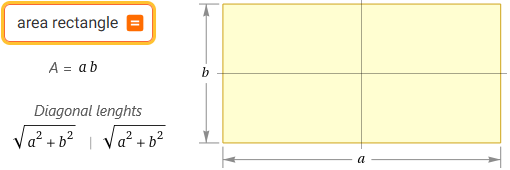
area rectangle 21 cm, 32 cm ... area rectangle

triangle area calculator

triangle (3, 0) (0, 2) (6, 1) , triangle (3, 0)

cuboid surface area | complementary 39° (rectangular cuboid = parallelepipedo rettangolo)

acute triangle, obtuse triangle, right triangle
 | diamond area area del rombo |
 | rhombus diagonal 30, side 17 |

trapezoid area calculator

3.5 days -> hours | 10000 sec

(3 h 25 min 40 sec)+(2 h 52 min 34 sec)

minimal coin form 26.85 euros

1 euro | image euro

19:32:55

this month | now
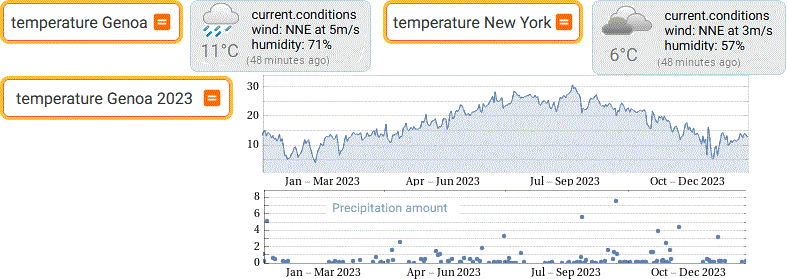
temperature ...

interval (0, 4), (2, 6], [4, 11]
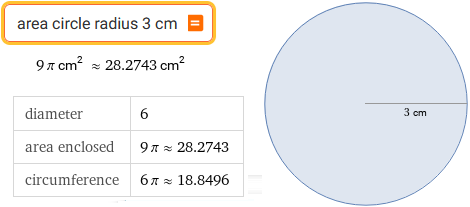
area circle radius 3 cm



angle 850 °
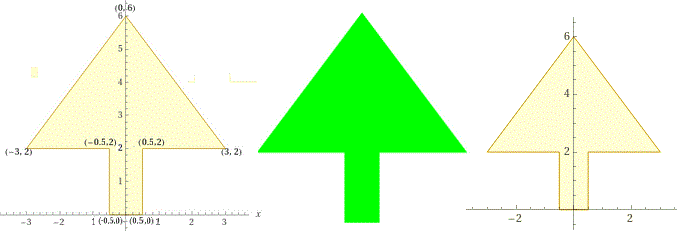

polygon ...
 | pie chart {60, 10, 30, 50} diagramma a torta |
|
|
 | 3/8 -> % |  | tape diagram 3/8 diagramma a nastro |
 | 5/6 -1/6 |


7/8 | mixed fraction 12.6 | 66.66...%
 | 0.2999... |
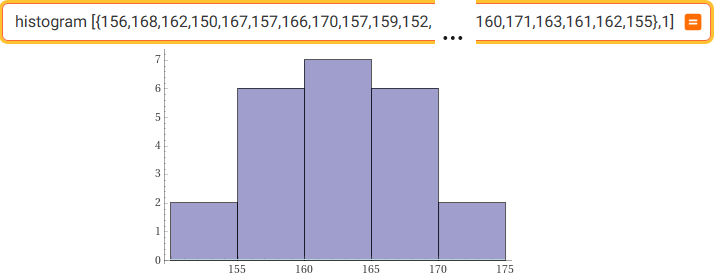
156, 168, 162, 150, 167, 157, 166, 170, 157, 159, 152, 164, 157, 165, 163, 169, 165, 160, 171, 163, 161, 162, 155
histogram [{156, ..., 155}, 1] [per più dati vedi sotto / for more data see below]

sort{156, ..., 155} median{156, ..., 155} mean{156, ..., 155} ordina, mediana, media
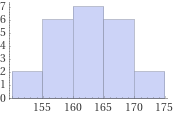 | se usi / if you use histogram {156, ..., 155} |

scientific notation of ...
| notazione scientifica |

factor ... fattorizza
 | divisors 24, 20, 12 gcd 24, 20, 12 |

multiples ... lcm ... multipli, minimo comune multiplo




simplify ... expand ... semplifica, sviluppa



equation solver

"> 0" → "sgn = 1" come esprimere le soluzioni di / how to express the solutions of 5x²+2x-8 > 0
 |
Se nelle soluzioni prodotte compare i queste soluzioni non sono da accettare. L'equazione a fianco non ha soluzioni. If i appears in the solutions produced, these solutions are not to be accepted. Equation a on the left has no solutions |

complete the square 6x^2+10x+28

solve system of 2 equations 1, 0, infinite solutions
 |

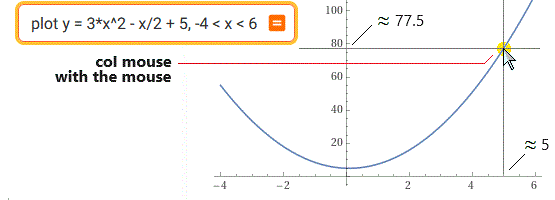
3*x^2 - x/2 + 5 if x = -3, -2, -1, 0, 5 plot y = 3*x^2 - x/2 + 5, -4 < x < 6

plot y = 2*(x-4)/3, -1 < x < 5

line (-1, 3), (4, -0.5)


line segment (0,4), (2,0), line segment (2,0),(8,2), line segment (8,2),(0,4)
Posso disegnare solo 3 figure con comandi espliciti / I can only draw 3 figures with explicit commands

plot y = -x, y = x, y=2x, y=x/2, -3 < x < 3, -2 < y < 2 | plot y = 1.5x, y = 1.5x +1, y=1.5x-1, -3 < x < 3, -2 < y < 2

plot y = 1/2*x^2-x+1, y = x^2-x+1, y = 2x^2-x+1, -2 < x < 4, 0 < y < 4
or: plot y = a*x^2-x+1 for a = 1/2, 1, 2, -2 < x < 4, 0 < y < 4
- - - - - - - - - - - - - - - - - - - - - - - - - -
With "points" and "segment line" a monometric scale is used. Even in the previous graphs the scale is monometric:
when you graph a function, to have a monometric scale take: width = 3/2*height
(or width = 1.5*height or: height = width/1.5 or: height = width*2/3)
Con "points" e "segment line" viene usata una scala monometrica. Anche nei grafici precedenti la scala è monometrica:
tracciando il grafico di una funzione per avere una scala monometrica prendi: larghezza = 3/2*altezza
(o larghezza = 1.5*altezza o: altezza = larghezza/1.5 o: altezza = larghezza*2/3)
- - - - - - - - - - - - - - - - - - - - - - - - - -
I grafici animati con desmos |  |



 | pendenza |  |

| pendenza cerchio parabola |
| angoli/lati/area di un triangolo |




tri ang-lato-ang tri lato-ang-lato tri lato-lato-lato


triangle ... side ... angle ...
A long road is inclined at (6.5±0.25)°. If I walk 240 m how much will I rise?
Una lunga strada è inclinata di (6.5±0.25)°. Se cammino per 240 m di quanto mi innalzo?

27.2 ± 1.1 m (≈ 27 ± 1 m)


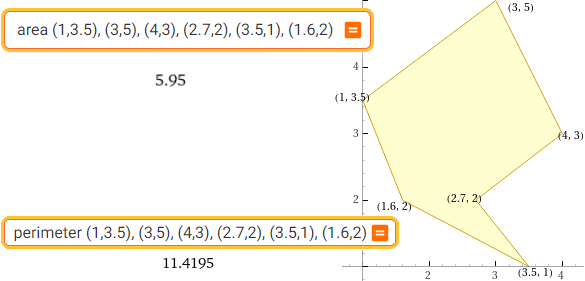
area (1,3.5), (3,5), (4,3), (2.7,2), (3.5,1), (1.6,2) | perimeter (1,3.5), (3,5), (4,3), (2.7,2), (3.5,1), (1.6,2)
| triangoli | quadrangoli |

triangle (0,0), (10, 0), (7,9), line segment (4,0),(7,9), line segment (8,6), (6*7/9, 6)

circle center (2,3) radius 2; circle center (2,3) radius 1 | circle (2.5, 3), (4, 0), (5.5, 1)

dist (-1,2), (3,6) | dist (0,0,0), (2,2,2) | dist (1, 0.5), y=3x+4 | dist (1,-2), line (-2,0),(1,6)

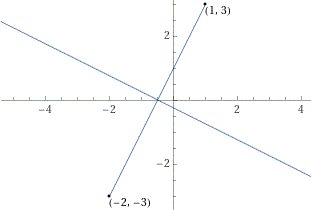
perpendicular bisector line segment endpoints (1,3), (-2,-3) asse di un segmento

heights triangle (-2,4),(2.5,3),(3,0.4) altezze di un triangolo

angle between (0.6, -1.5) and (2, 1.5)

| angolo ABC |

angle between (4--2, -1-1) and (3--3, 2-1)
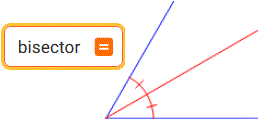 angle bisector bisettrice
angle bisector bisettrice
 |
i nomi dei punti sul cerchio unitario the names of the points on the unit circle |
| circle center(0,0) radius 1, line segment(0,0),(cos 30°,sin 30°), segment(0,0),(cos 120°,sin 120°) |
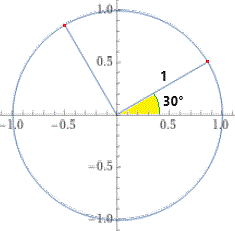 |
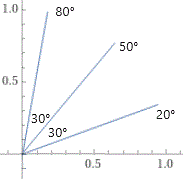 | line segment(0,0),(cos 20°,sin 20°), segment(0,0),(cos 80°,sin 80°), segment(0,0),(cos((20+80)/2°),sin((20+80)/2°)) la bisettrice dell'angolo con i lati nelle direzioni di 20° e 80° the bisector of the angle with the sides in the directions of 20° and 80° |

subsets of {a,b,c}

U | intersection | \

A U B | A intersect B | A \ B

relative difference

minmax B*H if (17-0.5 < B < 17+0.5, 12-0.5 < H < 12+0.5)
B = 17±0.5 cm, H = 12±0.5 cm → 189.75 cm² ≤ Area ≤ 218.75 cm²
Due località distano 33±1 km. Luigi ha impiegato, in auto, 23±1 min per percorrerla. Qual è la velocità media con cui ha viaggiato.
Two locations are 33±1 km apart. It took Luigi, by car, 23±1 min to travel it. What is the average speed at which he travelled.

minmax x/y if 33-1 < x < 33+1, 23/60-1/60 < y < 23/60+1/60
space = 33±1 km, time = 23/60±1/60 h → 80 km/h ≤ v ≤ 88.7 km/h
Gli istogrammi realizzati come visto sopra sono fattibili solo con pochi dati. Una alternativa (anche per migliaia di dati) è il seguente programma, che usiamo prima per gli stessi dati, poi per una quantità maggiore.
Incollo nel box i dati considerati sopra, premo "clicca" e poi "minimo", "massimo" (e se voglio "media" e "mediana"), metto "A", "B" e "numero intervalli" (e se voglio un "titolo") e premo "istogramma"
I paste the data considered above into the box, press "click" and then "minimum", "maximum" (and if I want "mean" and "median"), I put "A", "B" and "number of intervals" (and if I want a "title") and press "histogram"

Ecco l'istogramma dei pesi di 4170 giovani maschi ventenni italiani nel 1990
The body weight of 4170 Italian males in their twenties, in the year 1990
I dati
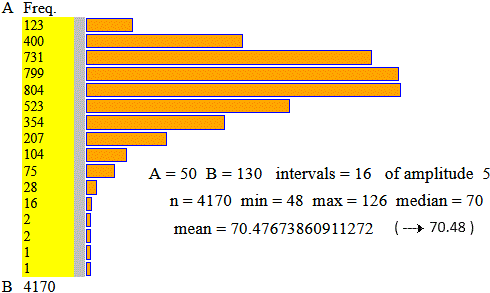
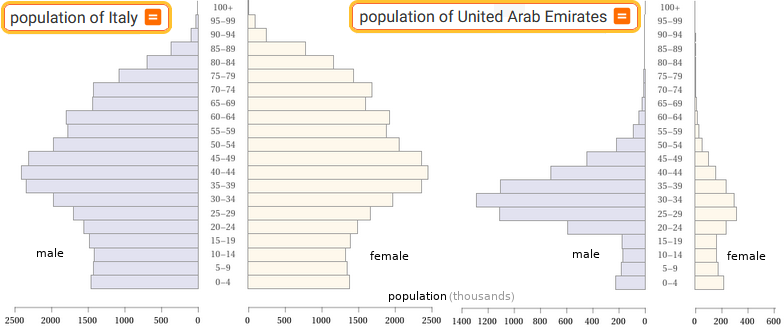
population of Italy | population of United Arab Emirates

solve 3/(1-x) > 2/x | plot 3/(1-x) > 2/x

x^2 >= 9 and 0 <= x < 5 and 64 > x^3 > 8

solve x^4 - x^2 + k = 0 for x real
"for x real" serve per escludere i casi in cui ho √ di numero < 0 / to exclude cases where I have √ of number < 0

intersect y = |x| and y = x^2
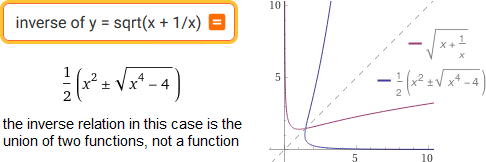
inverse of y = sqrt(x + 1/x)

rotation transform calculator
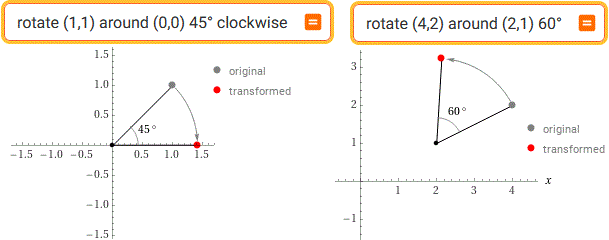
rotate (1,1) around (0,0) 45° clockwise | rotate (4,2) around (2,1) 60°

vector (-9, 12.8) The normalized vector, or unit vector ("versore" in italiano), has the same direction but length 1

trapezoidal rule

integrate -x^2+x+2 from -1 to 2

d/dx 3x^2-5x+1

lim (x^2+x-2)/(x-1) as x -> 1
Per altri esempi:



